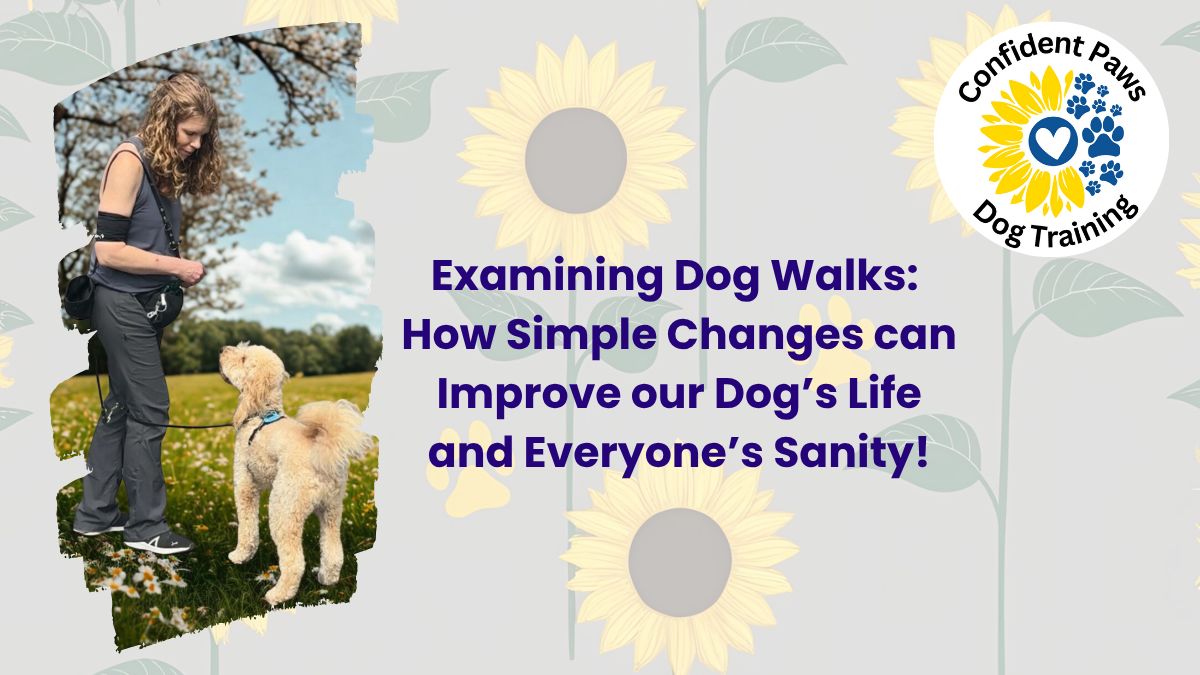Rethinking Dog Walks: From Daily Chore to Daily Connection

Ditch the Blame and the Guilt. The chore of walking around the block, isn't as essential as you might think!
Rethinking Dog Walks: From Daily Chore to Daily Connection
“Did you walk the dog?” It’s one of the most common questions asked in homes with pets. It sounds simple enough. But what if I told you that walking your dog isn’t just a daily to-do — it’s one of the most misunderstood parts of dog life?
Let’s reframe the walk. Not as an obligation. Not as a box to check. But as one of the most powerful tools for building connection, communication, and confidence — for both ends of the leash.
The “Standard Walk” Myth
Most people imagine a proper dog walk as a brisk loop around the neighborhood, preferably with no pulling, barking, or stopping to sniff every blade of grass. Bonus points if your dog ends up panting or too tired to cause trouble afterward.
But here’s the problem: that vision of the walk works for very few dogs.
For sensitive dogs, reactive dogs, or those living in overstimulating environments, the daily walk can feel more like a survival challenge than a bonding experience. And for many humans, it becomes something they dread — a stressful ritual they feel guilty for not doing “right.”
That’s not connection. That’s coercion.
What Dogs Actually Need on Walks
Dogs are sensory-driven creatures. Their walk isn’t just a chance to stretch their legs — it’s their version of scrolling the internet, checking email, and reading the news all at once.
What helps dogs thrive on walks:
-
Time to sniff (and decompress!)
-
Freedom to choose direction, pace, or interaction when possible
-
Predictability and safety, not chaos
-
Opportunities to feel successful, not overwhelmed
In short: they don’t need to “get their wiggles out.” They need space to feel safe, curious, and connected.
Shift the Lens: Walks as Relationship Work
Think of every walk as a conversation, not a command.
When your dog pulls toward another dog, spins at a leaf, or refuses to walk past a barking fence — they’re not being stubborn or “bad.” They’re communicating something about how they feel.
And when we respond with curiosity instead of correction, we deepen the relationship.
There’s also no rule that says a walk has to happen outside the house. Some of the best connection walks start in the living room — shift to the yard, and a fun game with a flirt pole can meet your dogs, physical, mental and emotional needs. This is more meaningful than dragging your dog past ten scary mailboxes. You may have to be a bit more creative - especially in urban landscapes where open space is limited. I've used parking garages, tennis courts, sniff spots, and even cemeteries (tad morbid I know, but free of other dogs!) It may take a bit more effort, but it WILL pay off and take pressure off of BOTH of you.
The Sunflower Approach to Walks
At Confident Paws, I use the Sunflower Method for emotional and behavioral growth — and walks are no exception. Here’s how we apply it:
🌱 Planting the Seed:
Start indoors or in the backyard. Practice loose leash skills and play-based connection games in a zero-stress environment.
🌿 Adding the Sun:
Take short, focused walks that prioritize predictability. Choose times of day and locations that feel safe, based off your dog's current developmental/behavioral situation. Build success by keeping the walk about connection, not distance.
🌻 Full Bloom:
With time, your walks become full of communication and confidence. There’s room for sniffing, sudden rainstorms, and even new challenges — but your dog stays connected to you, because the emotional bank account is full.
Walk Games that Build Connection
You don’t need to march to build skill. Here are some favorite walk-friendly games that turn training into joy:
-
Treat Magnet: A handful of treats near your dog’s nose, guiding them gently forward. This builds focus and calm through movement.
-
Up/Down Game: Ask for eye contact, mark it, drop a treat to the ground. This anchors attention and introduces pauses.
-
Emergency U-Turn: Not a punishment — a partnership pivot. Practice happy turnarounds that lead to treats and relief.
-
Permission to Sniff: Use a cue like “Go sniff!” to give your dog access to a favorite smell. It teaches self-control and builds anticipation.
The Bottom Line
You don’t need to walk your dog like everyone else.
You don’t need to “power through” a bad walk.
You don’t need to choose between structure and fun.
You get to build a walk routine that works for your dog, your environment, and your relationship.
Because walks aren’t just movement — they’re relationship in motion.
And when the relationship leads, the results follow.
Ginger Morris is a KPA-CTP certified positive reinforcement dog trainer and founder of Confident Paws Dog Training. She specializes in helping dogs and their people build stronger relationships by addressing the why behind behavior instead of just the what. Her playful, science-backed approach brings out confidence, clarity, and connection — one game at a time.
 Ginger Morris
Ginger Morris 